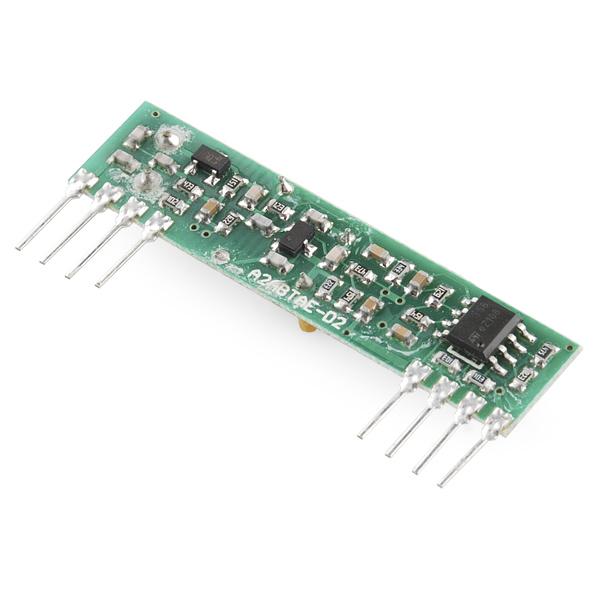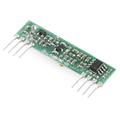Sparkfun RF Link Receiver - 4800bps (434MHz)

Description Attachments
One crucial aspect to note about these modules is their indiscriminate nature, which means they can pick up a considerable amount of noise. Given that both the transmitter and receiver operate at common frequencies and lack IDs, it is necessary to devise a method to filter this noise and pair the transmitter and receiver. An example code is provided for basic operation, and further resources can be found below for creating a reliable wireless data link.
These receivers bear a striking resemblance to the RF link 315MHz receiver. SparkFun ensures that you receive the exact product you requested. However, if you suspect that you may have received the wrong product, you can verify which version receiver this is by conducting a simple test circuit.
The RF Link Receiver boasts a range of features, including a frequency of 434MHz, a range of approximately 152 meters (under optimal conditions), a data rate of 4800bps, and a supply voltage of 5V.
Several documents are available to assist users in getting the most out of their RF Link Receiver. These resources include an Arduino Library, a datasheet, a KLP Walkthrough Tutorial, a useful AVR Tutorial, and a GitHub link.
Properties
| Brand | Sparkfun |
| Model | WRL-10532 |
| More info | KLP Walkthrough |
| Length | 54 mm |
| Width | 54 mm |
| Height | 9 mm |
| Weight | 3,6 g |
Customer questions
Customer Reviews
- In stock Sparkfun Copper Tape - Conductive Adhesive, 5mm - 15 meter € 7,75 View product
- In stock Sparkfun Teensy Stackable Header Kit (Extended) € 2,90 View product
- In stock Sparkfun RJ45 8-Pin Connector € 2,50 View product
- In stock Sparkfun Hobby Motor - Gear € 3,50 View product
- In stock Sparkfun Battery Holder 2xAA with Cover and Switch - JST Connector € 2,60 View product
- Sale In stock -72 % Sparkfun EasyDriver - Stepper Motor Driver € 21,25 € 6,05 View product
- In stock Sparkfun Thin Speaker - 4 Ohm, 2.5W, 28mm € 3,- View product
- In stock Sparkfun Alligator Clip with Pigtail (4 Pack) € 6,- View product
- In stock Sparkfun Toggle Switch € 3,30 View product
- In stock Sparkfun Clear Plastic Knob € 1,75 View product
- In stock Sparkfun Resistor 1K Ohm 1/4 Watt PTH - 20 pack (Thick Leads) € 2,15 View product
- In stock SparkFun Serial Basic Breakout - CH340G € 11,50 View product
- In stock Sparkfun Super Capacitor - 10F/2.5V € 6,25 View product
- In stock SparkFun Nano Power Timer - TPL5110 € 10,95 View product
- In stock Sparkfun Mini Photocell € 2,25 View product










